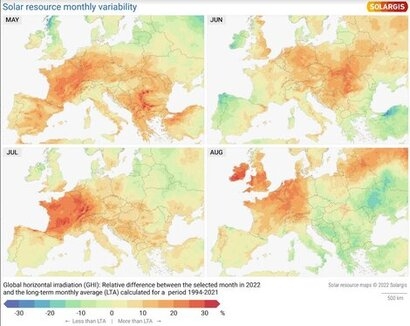
Solar data company Solargis has used its monthly maps to demonstrate that solar has maintained consistent performance across key growth markets including the US and France, highlighting its important role in the electricity mix as our climate continues to change.
In times of extreme heat and drought, electricity grids are put under increasing strain, with thermal power and nuclear lacking sufficient cooling resources, and prolonged high-pressure systems resulting in depressed wind power output. Despite the fact that extreme heat triggers slight reduction of photovoltaic modules efficiency, solar power performance is stable and predictable amid temperature extremes.
Consequently, while lack of rain and wind had exposed significant challenges for global energy sources ranging from nuclear to wind, solar power records continued to be set in Europe and North America. Solargis solar irradiance maps from this summer illustrate the stability and predictability of the solar resource in France and Texas - two energy markets that have faced significant strain caused by extreme heat.
Solargis’ monthly maps for July show 30 percent higher levels of solar radiation across France compared to long-term averages. This above average solar resource correlated with an increase in output and the first week of July saw 604 GWh of solar energy production registered in France – the highest in its history.
In contrast, French nuclear power has suffered from a lack of rainfall, coupled with rising temperatures, affecting the efficacy of its cooling systems and leading to reduced output.
In August, with precipitation 80mm below average, further strain was placed on France’s nuclear generation, while solar output grew in clear conditions. While two reactors were closed as a result of warm waters in the Rhône River, French solar recorded a new daily record output on August 7th, with over 10.7 GW generated.
“While solar is still a very minor part of France’s overall energy mix, the extreme weather we have witnessed shows the potential for French solar to play an important part in the energy mix as conventional and nuclear generation struggles” said Solargis CEO Marcel Suri. “France plays a major role in maintaining European energy security and it is time that solar is considered seriously as part of a stable long-term transition.”
The effects of the July heatwave on the Texan grid have been well publicised. High pressure systems responsible for high temperatures have also impacted the wind resource. With the most wind turbines in the US the country’s largest wind power producer dropped to 8 percent output in early July as extreme summer climate conditions presented reduced wind values.
Meanwhile, Solargis’ monthly maps indicate that, across the US, July saw 25 percent higher-than-average irradiance levels for the North-East United States, Florida and Texas, highlighting the potential for increased investment in solar in these states.
While the maps indicate that the solar resource is stable, wind and rain dropped off considerably, with The Electric Reliability Council of Texas (ERCOT) warning of dire consequences owing to “a projected reserve capacity shortage with no market solution available.” As these extreme weather events look to become more commonplace, the future of solar looks bright for Texas, with high irradiance levels and a projected 31 GW in the ERCOT development pipeline.
“The rise of predictable solar provides a big opportunity for stabilising the Texan grid” said Giridaran Srinivasan, CEO for Solargis America. “As evidenced by our maps, solar is paying off dividends as an alternative power source as the state continues its energy transition. It is heartening to see the wider U.S commitment to solar through the Inflation Reduction Act which, through its Investment Tax Credit, should accelerate the development of energy storage facilities to utilise the energy produced during peak solar periods.”
For additional information:

